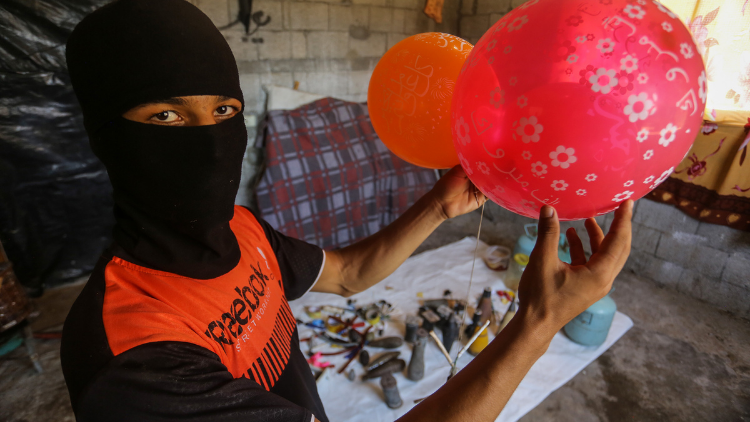MENAPOL Blog
Gaza is Going Nowhere

The weapon of choice is often no more than a condom, filled with helium, or a children’s balloon, and a flaming rag attached to it. Once let go, the device surfs the prevailing wind, blowing in from the Mediterranean Sea, across the fence into Israel where it can set fields or forests on fire.
The incendiary balloon, as well as incendiary kites, came into fashion at the 2018 border protests and have plagued Israeli communities adjacent to the Gaza fence ever since.
Israel has developed an aerial defence system to shoot rockets from the sky, it has built an underground barrier against attack tunnels, it has ways of monitoring almost everywhere in the 365 square kilometre enclave on its South-Western flank. Yet, so far all the military masterminds have not come up with a way of stopping the flying balloons that sometimes cause two dozen fires in a day.
“This is not a strategic threat, but it is also not marginal. The government has to defend the border communities; that’s why the military retaliates much more forceful now”, says Dr. Kobi Michael who used to head the Palestinian desk at Israel’s Ministry for Strategic Affairs and is now a senior research fellow at the Institute for National Security Studies in Tel Aviv. The Israel Defense Forces (IDF) reacts to what it calls “arson attacks” by tank fire or aerial bombardments of military targets in Gaza. Israel undertakes further punitive measures in response to the flying fires, tightening its military blockade of the terrain: In recent weeks it had closed Kerem Shalom, Gaza’s main commercial crossing, and Gaza’s fishing zone. Also, Gaza’s only power plant halted its operation after Israel cut the fuel supply to the strip. This brought down the power supply from eight to twelve to now three to four hours a day, in peak summer heat.
“We can no longer tolerate the blockade that's been taking place for 13 years," explained a member of a Palestinian balloon unit to an Al Jazeera reporter between sending incendiary devices across the fence. Another one complained: “The world is looking the other way.” The Islamic terror organization Hamas, which has ruled over the strip since a short, bloody civil war in 2007, generally tolerates the balloons, citing “the right to resist the occupation”.
The recent round of violence lasted nearly one month until a ceasefire was agreed on the night of August 31. Before the Israeli sanctions had made life yet more unbearable for Gazans.
The population has grown to around two million in recent years making the coastal strip one of the most densely inhabited territories in the world. Two years ago the United Nations warned that Gaza would become “unliveable” by 2020 due to the dire infrastructure and economy situation. UN experts also expected that the population would increase even faster, to 4,8 million in 2050, outpacing that of the West Bank. Already, water contamination in the enclave has reached 97 percent, nearly 80 percent of the population receives some kind of aid, according to the World Bank, while nearly 53 percent has fallen below the poverty line. The unemployment rate of 45,5 percent is the highest in the world.
In addition to all this the authorities now face a severe fiscal crisis due to the negative economic effects brought about by Covid-19, which pushed them to slash the salary payments for workers in the public field. After rising case numbers at the end of August a full five-day lockdown was enforced to contain the virus. The pandemic could easily bring the already failing health system to its knees.
Matthias Schmale heads UNRWA, the United Nations Relief and Works Agency for Palestine Refugees, in Gaza. He was worried when assessing the recent escalation: “Recently we have heard a number of disturbing statements by Hamas, that Israel would have to bear responsibility should the health sector break down.” While both sides have no intention for another war, Schmale says, the pandemic crisis could be used to exert pressure: “Also for Hamas and Islamic Jihad to cover up their own failure.”
As problems in the enclave culminate yet again one thing became clear: Gaza is going nowhere. The problems will only increase, for its citizens and in turn for the Israelis who – together with Egypt – bear a great part of the responsibility and a an even bigger share of the international public’s blame. All sides need to ask themselves what can be done to alleviate the suffering, to bring about some level of calm and stability on both sides of the fence.
Continuous harsh statements from Israel’s political right are unrealistic, knows Kobi Michael. While an invasion to topple Hamas is “doable”, he asks: “What happens on the day after?” In addition to several billion Dollars of financial expenditures such a campaign and subsequent occupation would come at considerable political and social cost, nationally and internationally. The reactions to the last full-out campaign in 2014 (“Protective Edge”) serve as a friendly reminder.
“Mowing the lawn”, as some Israeli military strategists cynically call large-scale military action to reinstall deterrence, is far from sustainable, argues Gershon Baskin, an Israeli peace activist and vocal proponent of the two state solution: “The effects can only be gauged in hindsight. Also, Israel goes to war against people who are willing to die, and such a campaign always produces martyrs whose children then in turn long to die for the cause.”
Baskin proposes for Israel to instead take a number of unilateral steps, to ease the siege: issuing more permits for Gazan traders to work in Israel and the West Bank, allowing greater movement of goods, including exported ones such as furniture or strawberries, through Kerem Shalom, extending the fishing zone. Matthias Schmale of UNRWA has similar hopes. He knows that UN coordinator Nickolay Mladenov is engaged in on-going negotiations to stabilize the situation. The first step should be a long-term truce. This could be brought about by an exchange of prisoners (Hamas holds the bodies of two dead IDF soldiers and two living Israeli civilians), an increase of work permits and an extension of the fishing zone. Schmale knows: “There had already been considerable progress in these talks.” Should the truce hold a second step could be made: “To start a new political process on the ground, first with elections on the municipal level.”
Kobi Michael sounds more pessimistic. He sees Israel in a “Catch-22” as it needs to improve the humanitarian situation in Gaza while avoiding to aid Hamas and its partners. “Israel has not crossed the Rubicon on this yet, because that would mean accepting Hamas’ authority, its legitimate power.” It would also signify to Qatar and Turkey that their influence is accepted. Ankara, a major supporter of the Muslim Brotherhood, is an adversary of Egypt, which Israel depends on. After much debate last year Qatar has already been accepted by the Israelis as Gaza’s main source of income. Representatives of the Emirate regularly shuttle in via Tel Aviv’s Ben Gurion airport with suitcases full of cash. 30 million Dollars alone on a single visit at the end of August. Still, Qatar is far from being a friend or partner to the Israeli government.
Last not least, Hamas is also an opponent of the Fatah-controlled Palestinian Authority (PA) in Ramallah. “These two parties are engaged in a zero sum game”, explains Kobi Michael, “if Hamas makes gains in Gaza, this profits them also in the West Bank and thus weakens the PA. We cannot let this happen.” Michael concludes: “In Gaza Israel can only allow marginal changes.”
Analyst Omar Shaban of the Pal. think tank in Gaza is aware of these circumstances. He therefore says: “The only solution is to bring the PA back to Gaza.” Only this would reengage the international community and bring stability. But the Fatah-Hamas reconciliation has so far, over the course of 13 years, not reached any substantial results. Only some partial measures, such as the transfer of the control of the border crossings, were implemented. Additionally, Israel and the United States have spoken out against such a resolution.
There are many reasons to be pessimistic, finds Gershon Baskin: “For now I don’t see anything really changing until the leadership changes, in Israel, in Palestine, and hopefully also in the US.”
About the Author

